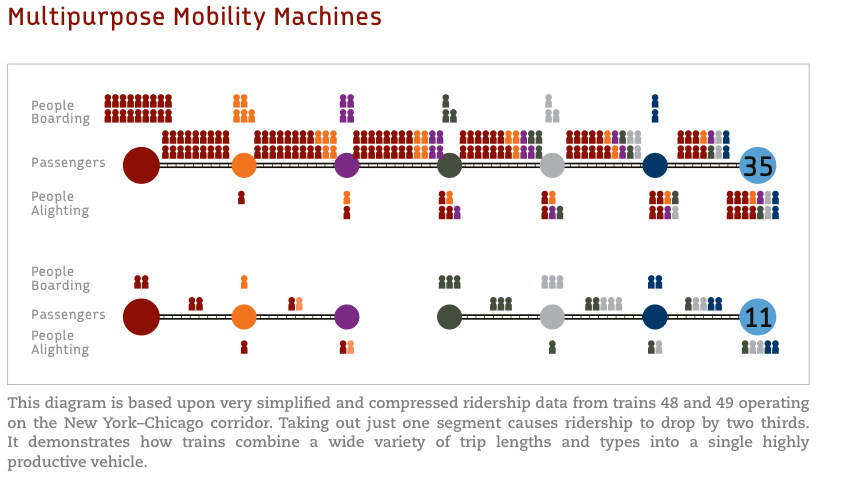MIDWEST HIGH SPEED RAIL ASSOCIATION & NATIONAL ASSOCIATION OF RAILROAD PASSENGERS
Long Distance Trains: Multipurpose Mobility Machines
Long distance train routes form the foundation of the national passenger train network. Their unique capabilities allow them to connect congested urban areas and bring economically viable mobility to rural areas and small towns, many of which are becoming more isolated from major cities as regional airline and intercity bus service disappears.
They represent a strategic platform for scaling up passenger train service that will improve American mobility.
The time has come to transform the national passenger train network from a neglected, barebones operation to a robust and thriving mobility machine by:
1. Filling gaps in the current network to create a grid and gateway system.
2. Increasing frequencies to allow daytime service to all stations.
3. Procuring high-performance trainsets suitable for overnight and longer distance trips.
4. Making track improvements that increase reliability and decrease trip times.
Mobility and a Healthy Economy
Mobility is the foundation of a healthy, vibrant, growing economy. Connecting people with a multilayered, interconnected network of travel choices is a powerful catalyst for creativity, innovation and high performance economic development. Mobility is so important to American society that it is recognized as a legitimate and important function of government.
For more than seven decades, government has focused public resources on developing road and air transportation. It is increasingly apparent, however, that America cannot continue to rely so heavily on these two transportation modes.
High-performance passenger trains are the keystones of flourishing, modern economies worldwide because trains offer a cost-effective and scalable way to provide mobility for a wide variety of trips.
The United States has begun to recognize the contribution passenger trains can make to our mobility and quality of life. However, in debating the nature and scope of a national intercity passenger train system, pundits and policy makers have largely ignored one entire category of trains: those that travel long distances between route end points.
There is an urgent need to make trains more widely available.
Despite such limited service, these 15 routes account for 42% of passenger miles carried by all of the nation’s intercity passenger trains. Clearly, these routes perform a significant transportation function.
Indeed, long distance routes form the foundation of the national passenger train network today and must be an important part of the effort to bring a new, high quality mobility choice to a wide cross-section of Americans. The unique capabilities of long distance routes allow them to connect congested urban areas and to bring economically viable mobility to rural areas and small towns, many of which are becoming more isolated from major cities as regional airline and intercity bus service disappears.
Long-distance routes represent a strategic platform for scaling up passenger train service that will improve American mobility, especially in markets where limited resources preclude the immediate implementation of high-speed rail.
As congestion and the price of oil make driving and flying more difficult and less affordable, the need to make trains a more widely available mobility choice grows increasingly urgent. Improvement and expansion of service on long distance routes represents a cost effective method of accomplishing this objective in a relatively short time for a large number of Americans.
Read full report (PDF) here: Long Distance Trains
About the National Association of Railroad Passengers (NARP)
narprail.org
“The mission of the National Association of Railroad Passengers (NARP) is to work for a modern, customer-focused national passenger train network that provides a travel choice Americans want. NARP is the largest national membership advocacy organization for train and rail transit passengers. We have worked since 1967 to expand the quality and quantity of passenger rail in the United States. Our work is supported by around 20,000 individual members.”
About the Midwest High Speed Rail Association
www.midwesthsr.org
“The Midwest High Speed Rail Association is a member-supported, non-profit organization advocating for fast, frequent and dependable trains linking the entire Midwest. We are promoting an integrated network of new, 220-mph high-speed lines combined with modernized Amtrak trains linked to strong local transit networks.”
Tags: Midwest High Speed Rail Association, NARP, National Association of Railroad Passengers







 RSS Feed
RSS Feed